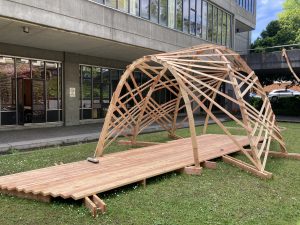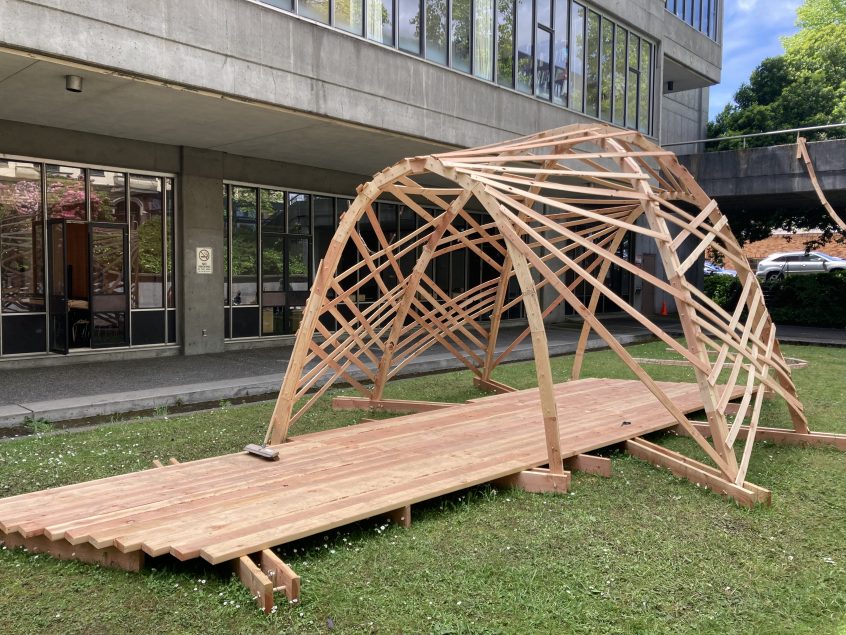Wood, one of the world’s oldest building materials, is now considered a material of the future – thanks to advances in the timber and design industries. Architecture students at the Barry Onouye Endowed Studio at the University of Washington dedicated 10 weeks of learning about the design potential of wood and put into practice their ideas this spring quarter.
Students were charged with designing and building dome-shaped structures made primarily of wood. The architecture students did use minimal metal fasteners in their timber domes to create their timber shells. Students were graded on aesthetics, strength and structure.
The class is made possible by an endowment to the school and strategic partnerships with Sustainable Forestry Initiative and the Sustainable Forestry InitiativeÒ Implementation Committee (WASIC). The donated wood was sourced from three mills based in different regions of the state: Sierra Pacific Industries, Hampton Lumber and Yakama Forest Products.

Photo courtesy of Sierra Pacific Industries.
“Seeing these structures is fun for us in the timber industry to see something that isn’t rectangular,” said Lisa Perry of Sierra Pacific Industries and WASIC member. “I hope they [students] understand all of the different ways wood can be used. It’s not just for framing a three-bedroom, two-bathroom house.”
During finals week, students unveiled their project. Perry noted that several students shared with her that designing and constructing the timber shell helped them achieve a deeper understanding of wood’s capabilities and recognize the unique qualities of wood grown in specific regions throughout the state.
“It’s exciting to be involved in a project that explores new and innovative wood use,” Perry said. “It was really gratifying to hear students talk about how great it was to work with wood and for them to actually work with wood as opposed to theory.”
Advancements in innovative timber products and growing attention to sustainable living is creating renewed interest in designing and building with wood. But it’s not just consumers, policymakers and developers demanding a greener built world, according to University of Washington Department of Architecture Associate Professor Tyler Sprague. Recognizing their important role in creating more environmentally friendly designs, architects and engineers also are motivated to explore groundbreaking approaches and applications using wood, he added.
“It’s not only external pressure,” Sprague said. “It’s certainly architects and engineers seeing wood’s design potential and environmental benefits. This is an exciting place to be.”
Traditional and engineered wood offers numerous environmental, practical and aesthetic benefits.
Sustainably produced forestry products are a part of the climate change solution, helping improve air and water quality. Working forests provide a renewable and environmentally friendly building material that is less carbon intensive than concrete and steel. Trees absorb carbon dioxide gas from the atmosphere and sequesters the carbon as biomass. Once harvested, the captured carbon remains locked in throughout the timber and forestry product’s lifespan.
Using wood and engineered wood in construction costs less, reduces leftover construction materials and can allow for a more streamlined timeline. Practically anyone can build and design with wood since it requires no heavy or advanced equipment and the beams, studs and joists can be cut to size. In the case of engineered wood, the components can be prefabricated offsite resulting in a reduced construction time and a decrease in excess construction site waste.

Photo courtesy of Sierra Pacific Industries.
There’s a growing body of research documenting the benefits of incorporating biophilic design. Using natural elements within the building spaces can lead to improved overall health and sense of wellbeing for occupants. In fact, wood offers innate acoustic properties that contribute to a peaceful environment and wood grain has been found to reduce stress, help with focus and increase productivity.
“The northwest has a long history of designing with timber,” Sprague said. “In some ways we’re rediscovering our more local ways to design with local trees.”
The timber shells will be featured at the 2022 Seattle Design Festival. The seven-day event will showcase designs at various locations August 20-26th throughout the city of Seattle. The event is free. Click here for more information.
